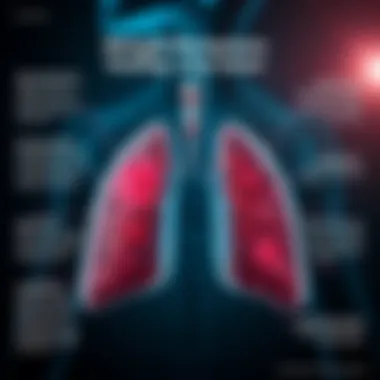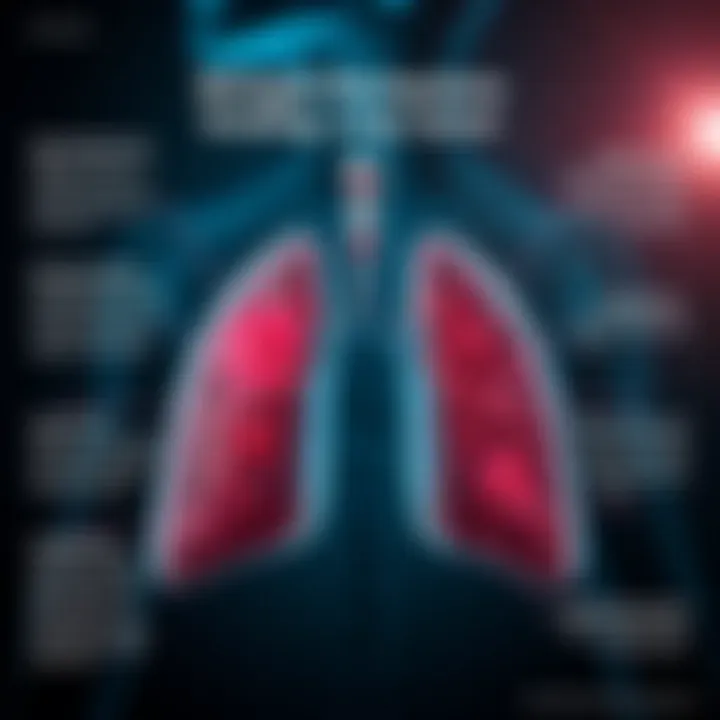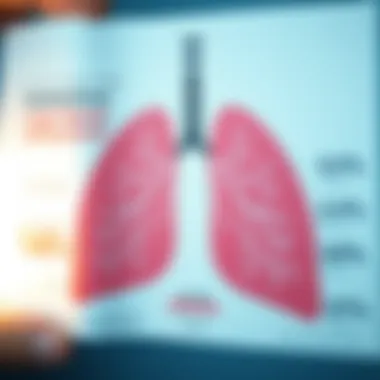Exploring the Connection Between Smoking and Lung Cancer


Intro
The relationship between smoking and lung cancer is as clear as day. When one thinks about lung cancer, the specter of smoking often looms large. It's a connection that's backed by a mountain of research, regulatory policies, and public health initiatives. This article aims to dissect that connection, peeling back layers to expose the biological, societal, and psychological threads that tie smoking with lung cancer.
As we delve deeper into the matter, it’s essential to grasp not just the numbers but the narrative behind them. Statistics can be eye-opening, yet without context, they might lack emotional weight. For instance, studies reveal that nearly 90% of lung cancer cases in men and 80% in women stem from smoking alone. That’s no casual correlation; it’s a clarion call for action. Also, in various communities, smoking rates don't just contribute to individual health issues but ripple through public health systems and healthcare costs.
A Brief Overview of the Themes
In this article, we’ll unfold the intricacies of the smoking-lung cancer connection through:
- Examining biological mechanisms that fuel the development of lung cancer.
- Analyzing statistical data that provides insight into the prevalence of this disease related to smoking.
- Illuminating risk factors that go beyond just nicotine addiction.
- Debunking myths and misconceptions that often cloud judgment regarding smoking and lung health.
- Highlighting effective preventative measures and alternative solutions that could mitigate the risks of lung cancer.
By the end of our deep dive, we hope to supply readers with a nuanced understanding, encouraging informed decisions whether you're a student, researcher, health professional, or a concerned citizen. The stakes are high, and the narrative is imperative, so let us embark on this exploration with clarity and purpose.
Prologue to Smoking and Lung Cancer
The relationship between smoking and lung cancer remains one of the most critical discussions in public health, given its profound implications for millions worldwide. Understanding this link is not only vital for health professionals but also for educators, researchers, and individuals who may be affected by this pervasive issue. With the dramatic rise in lung cancer diagnoses over the years, a clear grasp of the fundamental aspects surrounding smoking and its role in this disease is imperative.
Cancer of the lungs has become a leading cause of cancer-related deaths globally. Smokers are significantly more likely to develop lung cancer compared to non-smokers, shedding light on the detrimental impact of tobacco smoke. This article aims to dissect the nuances of this connection, offering insights that contribute to both awareness and advocacy for public health measures.
Understanding the Basics of Lung Cancer
Lung cancer primarily arises from the uncontrolled growth of abnormal cells in the lungs, resulting in the formation of tumors. These tumors can either be classified as non-small cell lung cancer or small cell lung cancer, with the former being the more prevalent type. The insidious nature of lung cancer often results in late-stage diagnoses, which complicate treatment options and reduce survival rates.
Many factors contribute to lung cancer development, but smoking tops the list. Tar and toxins in cigarette smoke cause chronic inflammation and damage to lung tissue, creating a fertile ground for cancer development. The body's natural mechanisms, designed to repair cellular damage, may eventually falter under the sheer volume of exposure to carcinogenic compounds present in smoke.
In simpler terms, it’s like trying to put out a forest fire with a bucket of water instead of a fire truck; the damage can far outweigh the capacity to heal.
Historical Context of Smoking and Cancer Research
The narrative of smoking and its link to cancer is steeped in history. In the 20th century, growing evidence began to emerge about tobacco’s role in lung cancer. Studies, beginning in earnest during the 1950s, began to solidify the association between smoking and cancer risks.
One landmark study published by Richard Doll and Austin Bradford Hill demonstrated clear statistical data correlating smoking habits with lung cancer rates. This was a game changer—not just for public health, but for our collective consciousness about risk. Since then, extensive research has continuously reinforced these findings, establishing smoking not merely as a habit but as a leading cause of a disease that claims lives at an alarming rate.
Over the decades, policy responses have evolved, likely spurred by public outcry and undeniable evidence. From warnings on cigarette packs to outright bans on advertising, lawmakers have begun to react to the tragic implications of this habit. As society continues to grapple with this issue, understanding the historical developments in smoking and cancer research allows us to ground our current position in a well-informed context.
For more insights on this topic, consider exploring resources from reputable institutions such as National Cancer Institute or academic archives like PubMed.
This examination paints a broad picture of how smoking leads not just to lung cancer, but also influences broader health discussions, emphasizing the onus on collective societal action for effective public health strategies.
Mechanisms of Carcinogenesis
Understanding the mechanisms of carcinogenesis is crucial in grasping how smoking contributes to the development of lung cancer. The process involves intricate biological and chemical interactions that lead to cellular changes deemed cancerous. By diving into these underpinnings, we can better comprehend not only the risks associated with smoking but also the underlying factors that may enhance this risk. The conversation surrounding these mechanisms goes beyond the simple acknowledgment of harm; it draws attention to how cigarettes are engineered to be addictive and the biological vulnerabilities that lead to cancer.
Chemical Composition of Cigarette Smoke
Cigarette smoke is a toxic cocktail, teeming with over 7,000 chemicals, many of which are harmful. Some of the most concerning components include:
- Nitrosamines: These compounds are known carcinogens formed during tobacco processing. They are among the most potent cancer-causing agents found in cigarettes.
- Polycyclic aromatic hydrocarbons (PAHs): Originating from incomplete combustion of organic material, these compounds can cause severe DNA damage and have a strong correlation with lung cancer.
- Acrolein: This is an irritant that disrupts mucosal health in the lungs, promoting inflammation and making lung tissue more susceptible to cancer.
The sheer volume and variety of these chemicals contribute to a cascade of biological effects that can alter cellular function. Continuous exposure generates an environment conducive to abnormal cell growth and enhances the probability of mutations, emphasizing the significant hazards that lie within each puff.
DNA Damage and Repair Mechanisms
DNA serves as the blueprint for life, governing cell behavior, growth, and function. Smoking triggers a deliberate assault on this blueprint through various mechanisms that cause damage. Key points to consider include:


- Direct DNA Damage: Carcinogenic inhalants can initiate direct alterations to the DNA structure, creating mutations that may compromise cell integrity.
- Oxidative Stress: Cigarette smoke induces an increase in reactive oxygen species (ROS) within cells. These ROS can wreak havoc on cellular structures, including inducing further mutations.
- Impaired Repair Mechanisms: Beyond just damaging DNA, smoking also hampers the body's natural capacity to repair this damage. When the repair systems falter under the continuing onslaught of toxic exposure, the accumulation of mutations becomes a catalyst for cancer progression.
"The more DNA damage, the higher the likelihood for malignant transformation."
Understanding these factors aids in delineating how smoking contributes to lung cancer, presenting a comprehensive view of the carcinogenic process. Exploring the interplay between chemical exposure and cellular response equips us with knowledge that can inform prevention strategies and support public health initiatives aimed at lowering smoking rates.
Epidemiological Evidence
Epidemiological evidence serves as a cornerstone in understanding the complex relationship between smoking and lung cancer. The patterns and data derived from this type of research are crucial for several reasons. First, they provide a comprehensive overview of how widespread the issue is, helping health professionals and the public grasp the magnitude of the problem. Secondly, statistical trends can shed light on demographics most affected, which can guide targeted interventions. Notably, exploring these statistics can reveal critical insights into how smoking habits have evolved over time, reflecting societal changes and influencing public health policy.
Statistical Trends in Lung Cancer Incidence
Historically, lung cancer has been a leading cause of cancer-related deaths worldwide. According to the World Health Organization, lung cancer accounts for approximately 1.8 million deaths annually, a staggering number that underscores the urgent need for clear data. The correlation between smoking habits and lung cancer incidence cannot be overstated; there exists an almost direct line from tobacco use to the rise in lung cancer cases. For instance, in the United States, the incidence of lung cancer among men flourished in the mid-20th century, aligning neatly with post-war spikes in smoking rates.
Recent analyses highlight some alarming trends among specific groups. For example, the rates of lung cancer are seeing gradual climbs among younger women, a demographic that historically smoked less than their male counterparts. The shifting landscape of public smoking bans and changing gender roles in society has contributed to this trend, illustrating how smoking habits can evolve and reveal new vulnerabilities.
- Key Statistics
- The American Cancer Society indicates that women who smoke are 13 times more likely to develop lung cancer than non-smokers.
- If current trends continue, lung cancer deaths in women are expected to surpass those of men.
"Understanding the statistical trends can inform prevention strategies and tailors education efforts toward specific populations most at risk."
Evaluating Risk Factors Beyond Smoking
While smoking is undoubtedly the primary risk factor for lung cancer, it is crucial not to overlook other contributors. Factors such as genetic predisposition, exposure to secondhand smoke, and environmental toxins like radon and asbestos also play significant roles in lung cancer development.
- Additional Risk Factors
- Genetic Factors: Certain genetic mutations may predispose individuals to lung cancer, indicating that family history can play a pivotal role.
- Occupational Hazards: Workers in industries like construction, manufacturing, and mining may be more susceptible due to exposure to carcinogenic substances.
In understanding these diverse factors, health professionals can develop more nuanced prevention and intervention strategies, ensuring a multifaceted approach to combating lung cancer. As we gather more information about these risks, it becomes clear that efforts to mitigate smoking alone won't be enough; we must consider a broad set of variables that contribute to this serious health issue.
For further reading, consider these informative resources:
Through this examination of epidemiological evidence, we can better understand not just the direct consequences of smoking, but also the broader picture of lung cancer risk factors, paving the way for informed public health strategies and more effective smoking cessation programs.
The Role of Genetics
Genetics plays a pivotal role in understanding how individuals may respond to environmental factors like smoking, particularly in the context of lung cancer. The inherent differences in genetic makeup mean that some people are at a higher risk for developing this disease when they smoke compared to others. The exploration of genetic factors can shed light on why not every smoker develops lung cancer, despite the well-established correlation.
A significant aspect is the identification of genetic markers that could predict susceptibility to lung cancer. By exploring these markers, researchers aim to develop personalized screening methods and treatment plans tailor-made for individuals based on their genetic profiles. This personalized approach signifies a transformative stride forward in cancer treatment, making it crucial for the ongoing research landscape.
Genetic Predisposition to Lung Cancer
Some individuals carry mutations in specific genes that make them more vulnerable to lung cancer, even if they have minimal exposure to smoking. For instance, the TP53 gene, often referred to as the "guardian of the genome" due to its role in regulating cell division and preventing tumor formation, is frequently mutated in lung cancer patients. The presence of these mutations may increase susceptibility to lung cancer when combined with environmental triggers like smoking.
In addition to TP53, other notable genetic factors have been identified, such as genes involved in detoxifying harmful substances found in cigarette smoke. Genetic variants in enzymes, like CYP1A1, can influence how effectively an individual can break down and eliminate carcinogens. Those with certain variants may struggle to detoxify these substances, leading to a higher risk of mutation and cancer development.
"Genetic testing could provide crucial insights, changing the landscape of lung cancer prevention and treatment strategies for at-risk individuals."
This intersection of genetics and lung cancer underscores the importance of continued research. By understanding the link between specific genetic markers and the development of lung cancer, researchers can pave the way for targeted prevention strategies. The significance goes beyond just predicting potential outcomes—it can also inform the choices patients and healthcare professionals make together.
Interaction Between Genetic and Environmental Factors
The relationship between genetics and environment is often intricate and multifaceted. While certain genetic predispositions increase susceptibility to lung cancer for individuals, environmental factors like smoking can act as catalysts, triggering the manifestation of previously dormant genetic risks.


For example, a person might inherit specific genetic susceptibilities from their parents. However, it is the act of smoking—an environmental toxin—that may activate these genetic factors, leading to the onset of lung cancer. The interplay between genes and smoke involves a complex system of interactions, including how genes regulate the body's response to carcinogens present in cigarettes.
Moreover, individuals with a genetic predisposition who smoke may experience a more aggressive form of lung cancer, raising important questions about how lifestyle choices interact with biology. This calls for a dual approach to lung cancer prevention: addressing both genetic factors through research and public health initiatives aimed at reducing smoking rates among high-risk individuals.
Thus, understanding the synergy between genetic predisposition and environmental influences can enhance the assessment of lung cancer risk and aid in developing tailored interventions. As research in this area continues to evolve, the hope is that targeted prevention and treatment options will emerge, providing better outcomes for those affected.
Myths and Misconceptions about Smoking
The prevalence of myths surrounding smoking and its effects on health, particularly lung cancer, cannot be overstated. These tales, often propagated by misinformation or a lack of proper knowledge, contribute significantly to misunderstandings about the true nature of smoking and the risks involved. It is vital to dissect these misconceptions to clarify the dangers that smoking poses, not only to smokers but also to those around them. By doing so, we arm individuals with accurate information that can lead to healthier decisions.
Common Beliefs Debunked
- "It's only a few cigarettes a day; it won't hurt me."
Many believe that occasional smoking is less harmful. However, research shows that even light smoking can lead to significant health risks, including lung cancer. Studies have indicated that any level of tobacco exposure can contribute to DNA damage, increasing susceptibility to malignancies. - "Natural cigarettes are safe to smoke."
A common misconception is that organic or natural cigarettes reduce risk. In reality, they can contain similar carcinogens as regular cigarettes. The term "natural" may mislead users into thinking they are making a healthier choice when in fact, they remain just as dangerous. - "Smoking is just a personal choice; it doesn't affect anyone else."
This belief undermines the concept of secondhand smoke. Numerous studies have demonstrated that secondhand smoke poses serious health risks to non-smokers, leading to lung cancer and other respiratory diseases. The idea that smoking solely affects the smoker is a misguided notion that requires correction.
These myths can create an illusion of safety around smoking, leading to complacency and harm.
Understanding the Misleading Information
Misleading information about smoking often arises from anecdotal evidence, misrepresented scientific findings, or marketing tactics aimed at downplaying the dangers of tobacco.
- Anecdotal evidence: People often recount personal stories of acquaintances who smoked for decades without developing lung cancer. While these stories exist, they do not reflect the statistical reality that the risk of developing lung cancer increases dramatically with smoking.
- Misrepresented scientific findings: Some articles might cherry-pick data or present findings out of context to support their narrative. For example, a study might show that a certain group of smokers lived longer than non-smokers, but this does not take into account other health factors or external influences affecting those individuals.
- Marketing tactics: Tobacco companies have historically used persuasive language to romanticize smoking, portraying it as stylish or desirable. This messaging has played a substantial role in shaping cultural attitudes towards smoking, obscuring its negative health implications.
Given the volume of misleading information available, it’s crucial to approach smoking-related claims with skepticism and seek evidence-based resources. Trusted websites like Cancer.gov or CDC.gov provide scientifically-backed information that can clarify the realities surrounding smoking.
"The truth is, the longer you smoke, the greater your chances of developing lung cancer, regardless of the myths that suggest otherwise."
In sum, addressing myths and dissecting misleading information is key to understanding the real dangers of smoking. Ignorance is certainly not bliss in this scenario; it’s essential to foster informed discussions and understanding among current smokers and those contemplating the habit.
Preventative Measures and Public Health Strategies
The fight against lung cancer, particularly given its association with smoking, necessitates a multi-faceted approach. Preventative measures and public health strategies play a pivotal role in reducing incidence rates and improving health outcomes. Addressing this issue is not just about narrowing the focus on smoking cessation; it encompasses a broad spectrum of strategies aimed at education, legislation, and community involvement that can create a safer environment for everyone.
Education and Awareness Programs
Education stands as the cornerstone of effective public health strategies. Informing individuals about the risks associated with smoking and lung cancer can sway personal choices and bolster communal efforts to combat tobacco use. Programs aimed at educating both youth and adults about the dangers of smoking have seen positive results. For instance, schools often implement anti-smoking campaigns that include informative sessions, workshops, and interactive activities. Such initiatives can even engage peer leaders to speak on their experiences and the realizations that can deter their peers from picking up the habit.
Besides direct communication strategies, innovative campaigns employ social media to connect with a broader audience, which is particularly effective among younger demographics. The use of visually impactful imagery and compelling narratives in these campaigns allows for more profound engagement, often encouraging individual contemplation and group discussions. Here’s a list of some vital elements that make these programs successful:
- Accessibility: Programs must be easy to attend and understand for all age groups.
- Relatability: Using real stories to illustrate the dangers can be more impactful than abstract statistics.
- Support Systems: Linking participants with local support groups for those wishing to quit creates a safety net.
"Knowledge speaks, but wisdom listens." - Jimi Hendrix
Fostering an environment of knowledge not only leads individuals to make informed health choices, but it may also nip smoking habits in the bud before they start.
Policies and Regulations
On the policy front, government actions can have a sweeping impact on smoking rates and consequently on lung cancer cases. Regulations do not merely work as deterrents but also signal societal norms regarding smoking. Here’s how effective policies typically pave the way:
- Age Restrictions: Rigorous laws that restrict tobacco sales to minors help to decrease smoking initiation among youth.
- Public Smoking Bans: Extending smoke-free environments in public places—restaurants, parks, and workplaces—minimizes secondhand smoke exposure while simultaneously de-normalizing smoking behaviors in public spaces.
- Tobacco Taxes: Raising prices on tobacco products through taxation has a substantial impact on consumption rates, particularly among younger users.
- Campaign Funding: Allocating public funds towards anti-tobacco campaigns promotes awareness and delivers strategies for quitting.
Effective public health strategies revolve around a combination of education and regulation, often reinforced through community collaboration. Mobilizing local health organizations for outreach, partnering with schools, and working with non-profits can maximize the reach and impact of these programs.
In summary, preventative measures hinge on proactive education alongside stringent regulations. The blend of both can foster a culture of health-awareness and diminish the stigma associated with quitting smoking. By keeping individuals informed and implementing supportive policies, we can not only address the continuum of lung cancer risks but also pave the way for healthier generations.
Treatment Approaches for Lung Cancer


When discussing lung cancer, the conversation inevitably transitions to treatment options. Understanding these approaches not only empowers patients and their families but also highlights the importance of timely medical intervention. By identifying potential therapies and their effectiveness, one can grasp a comprehensive view of managing this serious illness. Throughout this section, we will delve into current treatments, their outcomes, and emerging therapies that could reshape the landscape of lung cancer care.
Current Treatments and Their Efficacy
The landscape of lung cancer treatment is diverse, comprising several established methods. Each treatment option carries its own set of advantages and considerations. Here’s a snapshot of the most commonly employed treatments:
- Surgery: Often the first route considered for patients diagnosed in the early stages. Surgical procedures aim to remove the tumor and surrounding tissue. When successful, this can lead to favorable outcomes. However, the feasibility of this option often depends on the tumor's size and location.
- Chemotherapy: This method uses potent drugs to target and destroy rapidly dividing cancer cells. While effective in shrinking tumors and preventing further growth, chemotherapy can come with substantial side effects, including fatigue and nausea.
- Radiation Therapy: This treatment employs high doses of radiation to eliminate cancer cells. It's commonly used to treat lung cancer when surgery isn't an option, yet its efficacy can vary widely based on the tumor's disposition.
- Targeted Therapy: A more recent advancement, targeted therapy focuses on specific genetic mutations within cancer cells, such as EGFR mutations. These treatments can be tailored to directly inhibit the growth of cancer by attacking these mutated pathways.
- Immunotherapy: This approach boosts the body’s immune response against cancer cells. Checkpoint inhibitors, for instance, help the immune system recognize and fight cancer more effectively. Early studies show promise, yet additional research is essential to clearly define its long-term benefits.
Each of these treatments may be used alone or in combination, typically referred to as multimodal therapy. The goal here is to maximize treatment efficacy while minimizing adverse effects. A multidisciplinary team of specialists often collaborates to create personalized treatment plans for patients, which can significantly enhance overall outcomes.
Research on Emerging Therapies
The field of lung cancer treatment is continuously evolving. As research progresses, several emerging therapies are at the forefront, promising to fundamentally change treatment paradigms. Following are some noteworthy focuses in current investigations:
- Personalized Medicine: This concept tailors treatment based on an individual’s genetic profile. Understanding the unique mutations in patient tumors allows for more targeted therapies that can lead to higher success rates.
- Combination Therapies: Research suggests that pairing traditional treatments with newer drugs may yield better results. For instance, combining chemotherapy with immunotherapy has shown improved outcomes in various studies.
- Liquid Biopsies: These tests analyze circulating tumor DNA in the bloodstream, offering non-invasive ways to detect mutations and monitor response to treatment. This innovation could lead to more timely adjustments in therapy as needed.
- CAR T-cell Therapy: Though primarily used in blood cancers, this technique involves modifying a patient’s T-cells to attack cancer cells more effectively. Clinical trials are exploring its application in lung cancer and may revolutionize treatment.
While these therapies are still under investigation, they carry the potential to shift treatment paradigms in lung cancer management. The ongoing commitment to understanding this disease through research not only offers hope to patients but also underscores the importance of continued funding and support for cancer research initiatives.
"Innovation in treatment approaches is crucial in the fight against lung cancer, fostering hope and enhancing the quality of life for patients."
For further information on lung cancer treatment options, visit cancer.gov and asthma.org.
The Future of Research
Research on the link between smoking and lung cancer is not just a historical journey through milestones and findings; it is an ever-evolving narrative that embraces technological advancements and new paradigms. As the medical community learns more about the intricate relationship between smoking and lung cancer, it becomes paramount to explore future directions in research. This exploration isn’t merely academic; it holds the potential to significantly impact public health strategies and individual choices.
In recent years, there has been a marked shift towards personalized medicine, which tailors treatment options to the individual patient’s genetic makeup and lifestyle choices. The intertwining of genetics and environmental factors is particularly promising. Understanding genetic predispositions not only helps in identifying high-risk populations but also paves the way for targeted therapies. This focus on personalized approaches ensures that patients receive the most effective treatments based on their unique biological profiles.
The Impact of Technological Advancements
Advancements in technology are transforming the landscape of tobacco research and cancer treatment. The development of high-throughput screening methods allows for swift analysis of thousands of compounds found in cigarette smoke, speeding up the identification of potential carcinogens. Furthermore, innovations like artificial intelligence and machine learning enhance data analysis capabilities, enabling researchers to discern patterns and correlations that might have been overlooked in traditional studies.
Some notable advancements include:
- Genomic Sequencing: This capability allows researchers to explore mutations associated with lung cancer in smokers vs. non-smokers, offering insights into molecular pathways involved in carcinogenesis.
- Biomarker Discovery: Innovative techniques are uncovering biomarkers that can predict lung cancer risk, helping in early detection and potentially lifesaving interventions.
- Targeted Therapies: Understanding molecular targets that influence cancer growth and progression leads to the development of therapies that are more effective and exhibit fewer side effects.
These technological strides not only bolster our understanding of lung cancer but also inspire confidence for future studies that could yield significant breakthroughs.
Avenues for Further Inquiry
The realm of smoking and lung cancer research is vast, opening up numerous avenues for investigation that remain largely unexplored. Issues ripe for further inquiry include:
- Longitudinal Studies: Following individuals over time can reveal how smoking habits influence cancer development at varying life stages.
- Exploring Alternate Tobacco Products: With the rise of vape use and other smoking alternatives, understanding their long-term impact on lung health is paramount.
- Social Determinants of Health: Investigating how socioeconomic factors influence smoking behaviors and access to care can provide comprehensive insights into preventative measures.
The conversation surrounding smoking and lung cancer is expanding beyond biological mechanisms to encompass the socio-economic and behavioral factors that influence health outcomes. This broader perspective will ultimately inform public health policies and educational programs aimed at reducing smoking prevalence and improving lung cancer outcomes.
"The future of lung cancer research lies in collaborative efforts that transcend disciplines, bringing together genetics, technology, and social science to forge solutions that are as complex as the disease itself."
In this evolving landscape, it’s essential that researchers, policymakers, and health professionals work hand-in-hand to ensure that emerging findings are translated into real-world applications, ultimately steering society towards a smoke-free future.
Ending and Final Thoughts
The connection between smoking and lung cancer is not just a medical concern but a societal one that bears implications for public health, education, and policy-making. Understanding this link is crucial, as it leads to a more informed populace capable of making educated choices regarding smoking behavior and its consequences. The insights gleaned from the complexities of this relationship can significantly impact health outcomes.
From analyzing the intricate biological mechanisms that link smoking to lung cancer, it's evident that the ramifications extend beyond mere statistics. While the data showcases alarming trends—rising incidences and mortality rates—the story isn't only about numbers but about lives affected directly or indirectly. Public health strategies fueled by this knowledge can thwart further growth in these grim statistics.
Summarizing Key Insights
As we reflect on the findings presented, several key points stand out:
- Biological Mechanisms: The chemicals in cigarette smoke lead to direct damage to lung cells, initiating the potential for cancerous growth over time.
- Epidemiological Trends: Statistics continue to reveal a stark reality where smokers face dramatically higher risks of lung cancer compared to non-smokers. This correlation is strong enough that smoking is recognized as the primary preventable cause of lung cancer.
- Genetic Factors: Individual genetic predispositions can influence susceptibility to lung cancer, making awareness of family histories essential in assessments.
- Misconceptions: The prevalence of myths surrounding smoking perpetuates ignorance and increases risk. Addressing these misconceptions is crucial to promote healthier behaviors.
- Preventative Measures: Effective public health policies are vital for combating smoking, including education programs designed to raise awareness of its dangers.
- Emerging Research: Continuous research is necessary to develop innovative treatments and prevention strategies that respond to changing demographics and patterns of tobacco use.
In closing, the relationship between smoking and lung cancer is a profound reminder of the importance of informed choices and proactive health measures. The conversation must continue to ensure that awareness leads to actions that ultimately save lives, making it imperative for students, researchers, and professionals alike to engage with this critical topic further.







